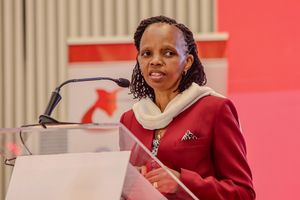It’s inching closer to energy trading

Turbines at the Lake Turkana Wind Power farm in Marsabit County. Governments ought to work towards having a market power pool that is responsive to the energy needs of their people. PHOTO | FILE | NATION MEDIA GROUP
What you need to know:
- Given the rapid urbanisation in most of Africa, the power sector deficit in the region subsequently leads to low manufacturing indices.
- There are various power projects taking shape such as the Grand Renaissance Dam in Ethiopia and Karuma Hydropower plant in Uganda.
In the recent past, the African continent has experienced dynamic development as manifested by the high rates of urbanisation currently registered at 3.6 percent annually.
This translates to nearly adding 350 million city dwellers by 2030, according to the Brookings Institution publication.
With such an exponential increase in population, it is incumbent upon the African governments to ensure that power infrastructure is developed at a pace needed to meet its growing demands.
Today, with nearly 45 million people, Kenya is not only one of the fastest growing economies in the Africa continent, but also a promising energy hub, as it positions itself for energy trade in the East African region.
WIND POWER
Currently, geothermal power accounts for 47 percent while hydro 39 percent of the national grid – connected energy mix and soon the largest wind park in Africa (Lake Turkana Wind Power) will plug some 310MW into the grid.
Additionally, a soon-to-be commissioned 54.6MW from the Garissa Solar farm will see the country edge closer to energy trading.
It has lately enhanced its cross-border electricity interconnectivity as an investment mechanism that supports the energy trade coordination to facilitate the development of a regional power pool.
Through the East African Power Pool (EAPP), critical steps towards efficient power trade among the 12-member states in the region are being put in place.
As the various countries seek to meet individual power deficit, cross-border energy trade has become a necessity.
AGENCIES
It does not make economic sense for countries to continue buying expensive thermal generated power while that very state has the option of importing, for instance, affordable and reliable energy resources from geothermal in Kenya.
The EAPP member states have since developed an East African master plan with mandates such as the establishment of a regional regulatory body as well as the construction of transmission lines and interconnectivity networks.
This is already evident in the strong link between the South Africa power pool and the East Africa power pool that has been made possible through the Zambia–Tanzania–Kenya 400KV transmission lines, commonly referred to as ZTK interconnectivity.
Kenya is also about to complete the 500KV Ethiopia–Kenya transmission line to evacuate further 400MW.
MASTER PLAN
The country’s Power Generation and Transmission Master Plan (PGTMP 2015-2035) anticipates surplus energy in the medium term, and renewable energy is among the must–run projects that are expected to result in a significant surplus between 2020 – 2024.
The South Africa power pool is the oldest and most developed market on the continent, where its successes and challenges have informed the West Africa Power Pool (WAPP) currently under establishment.
There are various other power projects in the region taking shape such as the Grand Renaissance Dam in Ethiopia to generate 6000MW, Karuma Hydropower plant in Uganda (600MW) and Kenya’s geothermal potential envisaged at 10,000MW, according to the Least Cost Power Development Plan (LCPDP 2017 – 2037).
DEMAND
Even with these and as well as other renewable energy projects, energy resources are not uniformly distributed in forms and locations hence the need to leverage on the market power pool and energy trade.
Once the various power projects throughout the continent and investment in transmission lines become operational, there will be a huge shift in the electricity market and energy trading and Kenya is well-positioned to benefit from this arrangement.
The Nord power pool, commonly referred to as the Nordic market, is the leading power market in Europe and is considered a model power pool globally with about 80 percent of energy consumption in Europe coming from the pool.
Given the rapid urbanisation in most of Africa, the power sector deficit in the region subsequently leads to low manufacturing indices.
Governments ought to work towards having a market power pool that is responsive to the energy needs of their people, particularly given that 650 million people in Africa do not have access electricity.
Mr Thuo is an energy adviser at the Africa Utility Forum. Email: [email protected]





